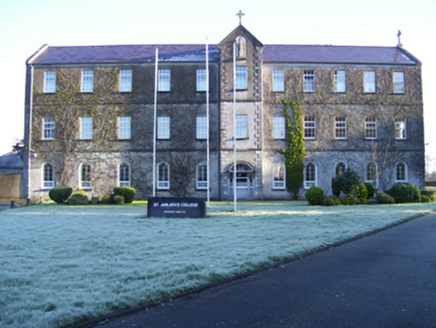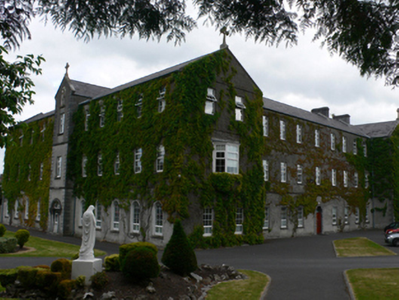Survey Data
Reg No
30331024
Rating
Regional
Categories of Special Interest
Architectural, Social
Original Use
College
In Use As
School
Date
1855 - 1860
Coordinates
143797, 252068
Date Recorded
21/04/2010
Date Updated
--/--/--
Description
Detached H-plan college, dated 1858, having substantial later additions to north-east. Main façade of nine bays and three storeys with advanced gabled wings of two bays which are ends of flanking ranges and have oriel windows. Latter ranges are eleven bays long with gabled single-bay breakfront to south-west range. Pitched slate roofs with ashlar limestone chimneystacks, those of entrance front set in pairs at each end. Limestone copings to gables with delicately carved crosses. Roughcast rendered walls with string courses between floors, and cut-stone plinth. Square-headed window openings to main façade and to upper floors of west range, with replacement uPVC windows and tooled limestone sills. Oriel windows are canted and supported on corbels. Round-headed doorcase having surround of dressed parallel blocks, and replacement timber door. Inscribed plaque over door commemorates foundation of college by Archbishop McHale in 1858. West elevation has single-bay entrance breakfront with raised quoins and carved limestone doorcase, now converted to window, comprising square-headed doorway flanked by paned sidelights, openings flanked by panelled pilasters with plinths and scroll brackets supporting moulded cornice and moulded archivolt to elliptical petal fanlight. Limestone panel and moulded sill to later window. Building surrounded by tarmaced area to front and lawn to west. Short range to west orginally possibly stables and is five-bay two-storey building with pitched slate roof, cast-iron rainwater goods, lime rendered rubble limestone walls, and having hexagonal building at west end. Replacement uPVC windows and slatted timber doors.
Appraisal
When this seminary was built Saint Jarlath's College was an important statement of the independence and status of the Catholic Church in Ireland. It was designed in a classical style to emphasise the traditional values of classical education and the authority of the Church. The College remains an important architectural and historical set-piece.



